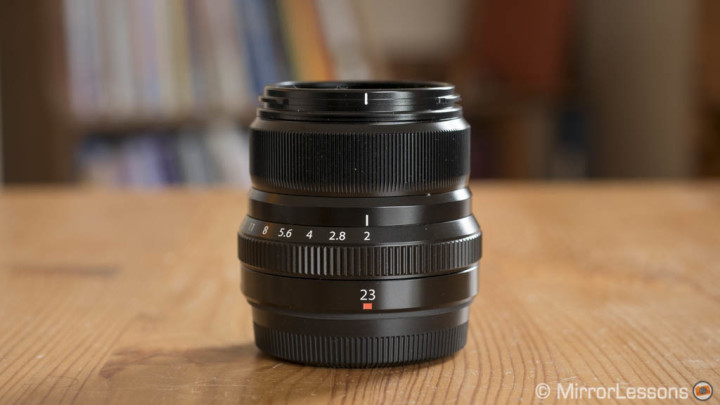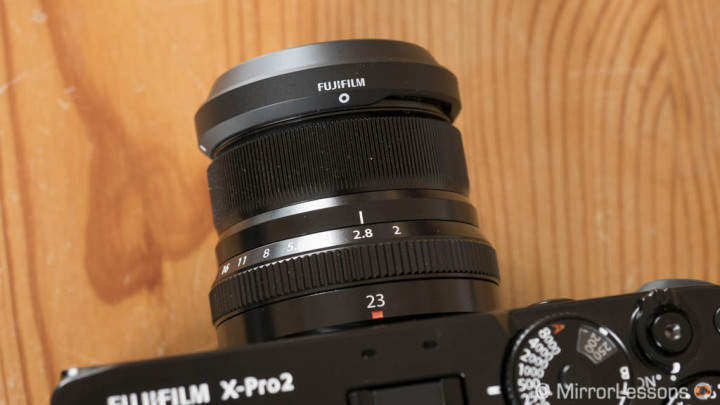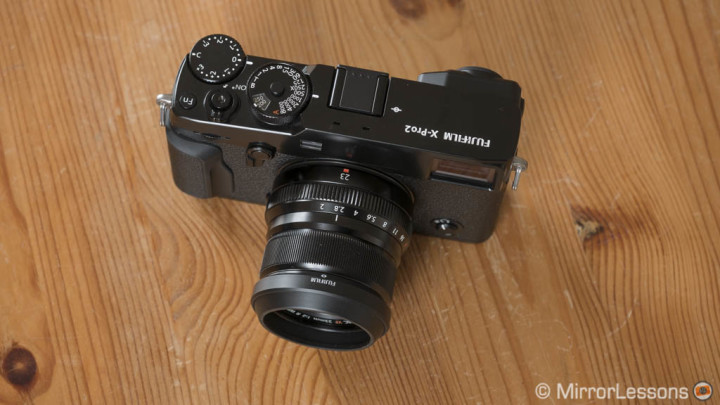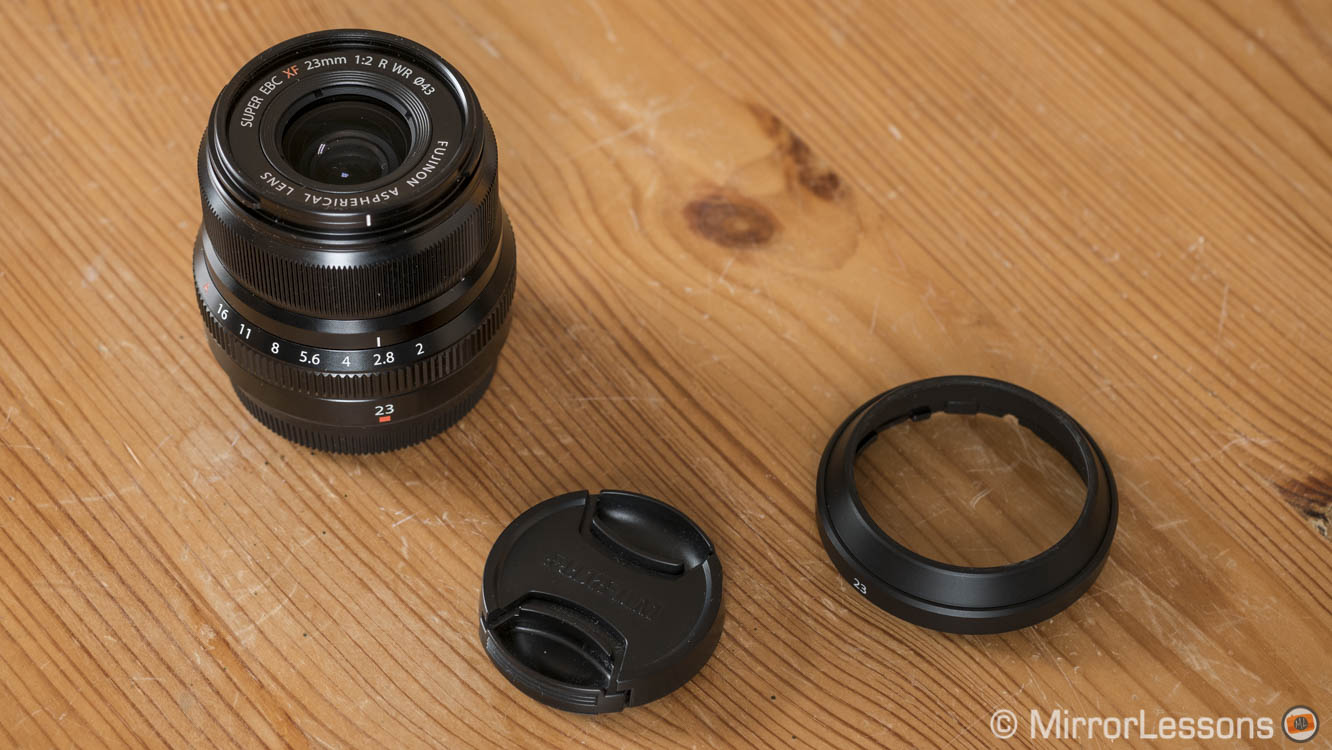The Fujifilm 23mm f/2 is the second 23mm lens designed for the X series, or maybe should I say the third lens if we take into account the X100 cameras that also feature the 23mm focal length.
This new lens is part of the f/2 lineup, a series of more affordable products that includes the 18mm Fuji developed four years ago and the 35mm f2 they released last year. The 23mm and 35mm are more recent with a better build quality and faster inner focus mechanism. With a 50mm f2 on its way, Fuji users will soon have an excellent range of reasonably priced prime lenses to choose from. That can only be a good thing for a growing mirrorless system.
I spent almost a month with the new 23mm while gathering images for my in-depth X-T2 review that is hopefully coming soon. Here is what I found.

[toc heading_levels=”3″]
Main Specs
- Mount: X-mount
- Format coverage: APS-C
- Focal length: 23mm
- Focal length (equiv. 35mm): 35mm
- Maximum aperture: 2
- Minimum aperture: 16
- Number of aperture blades: 9 rounded bladed
- Angle of view: 63.4°
- Closest focusing distance: 22cm
- Lens configuration: 10 elements / 6 groups
- Special elements: 2 Aspherical elements
- Maximum image magnification: 0.13x
- Optical Image Stabilizer: None
- Dimensions: ø60 x 51.9 mm
- Filter diamater: ø43mm
- Weight: 180g (excluding lens cap, lens rear cap, lens hood)
Video review
Below you can watch a video version of our XF 23mm f2 review.
Design and ease of use
The lens is small, light (180g only) and is comfortable to use on a flagship model like the X-T2 or mid-range camera like the X-T10. It has a nice all-metal construction and is weather sealed with freeze proofing down to -10°C.

The aperture ring clicks in 1/3 steps: it is precise and not too loose. The focus ring is of course a fly-by-wire type but like most modern lenses, it provides accurate results and is pleasant to use.

The lens comes with a tiny plastic hood that keeps the overall size of the lens compact while adding enough protection for the front element.

If you want to use it on the X-Pro2 and take advantage of the optical viewfinder, the good news is that the lens doesn’t get in the way too much. You can see it just a little in the bottom right corner but your field of view (bright frame) remains mostly clear.

Note that the lens lacks optical stabilisation and since Fujifilm cameras don’t feature in-body image stabilisation, there aren’t any options at slow shutter speeds if not the good old tripod. I also used a monopod for video and still shots. Concerning the latter, I managed to go down to 1/8s with decent results.
Through the lens: optical quality
The XF 23mm f/2 gives you the same angle of view as a 35mm designed for full-frame cameras. It’s one of those classic lenses that many people recommend if you are interested in street or reportage photography. Because this version is quite small and compact, I have to say it serves these two purposes very well.

Sharpness is decent wide open at f/2 but I do find the details a little soft when taking environmental portraits and shooting at a short focus distance. The lens of course is usable at that fast aperture but for optimal sharpness you will need to stop down.

Click to open the full res image.

Click on the image to open the full res version.
The softness at f/2 is valid for both short and long focus distances. If we take a look at the following test, we can see that sharpness increases at f/2.8 but becomes optimal from f/4. The peak performance is found at f/5.6.

The results remains good up to f/11 and at f/16 diffraction is very well-controlled.
One nice thing about this lens is that sharpness in the corners is not too dissimilar from the results found at the centre of the frame, so you get good corner-to-corner performance. This is a positive surprise that tells you how good the optical design is.
The XF 23mm f/2 can focus as close as 22cm which is good for capturing details. Sharpness wide open is not the best, however, and you may want to stop down to f/4 for optimal results.

Click on the image to open the full res version

Click on the image to open the full res version

You won’t get a stunning shallow depth of field with the 23mm given its moderate wide view and f2 aperture unless you focus really close. That being said, I like the character of this lens and you do get more than decent results overall. The out-of-focus background is creamy enough and the subject separation capabilities surprised me more than once.



The bokeh balls can have an irregular shape at the fastest aperture, then develop a more hexagonal shape from f/2.8.

Barrel distortion is well contained and is already corrected in-camera so you don’t have to worry about it even when post-processing the RAW files.

Flare resistance is excellent. I only found some very weak traces of veiling flare in direct sunlight but it wasn’t always easy to find it in the picture.



Finally you can notice some little traces of chromatic aberration when loading the RAW files into Lightroom or other softwares. If you activate the automatic Remove Chromatic Aberration tool, you should be able to get rid of most of it.

Autofocus performance
The XF 23mm f/2 is really fast and honestly I am not sure what other relevant information I can add. It performed really well on the X-T1, X-T2 and X-Pro2, in Single and Continuous Autofocus. The AF motor is silent and the focus mechanism is internal, meaning the lens doesn’t extend when focusing.
I used this lens in many different conditions but the most difficult situation I found myself in was at a Halloween ghost walk in the woods. It was pitch dark with very weak lights illuminating the various sets. I had to keep my ISO cranked up to 12800 most of the time just to give you an idea. The X-T2 struggled a little in some situations but as far as the lens is concerned, it always focused fast without back and forth movements or other weird behaviour.



I also used the 23mm f2 for a few video shots in both good and low-light with continuous AF. The focus transition was always quick and precise. You can see a few examples below at minute 1:32 and 4:33.
Conclusion
I’ve seen lots of positive feedback about this new f/2 series and I was really curious to get my hands on one of the new lenses. I have to admit that there aren’t many negative things I can say about the XF 23mm f/2.
The autofocus is really fast in all situations, for stills and video. Flare resistance is excellent and sharpness is good both at the centre and in the corners from f/4 onwards.
I do find the lens a little soft at f/2 and that’s probably the only criticism I have. This doesn’t mean it’s not usable wide open but for optimal sharpness, you need to stop down to f/4.
I like the character of the lens though, and the shallow depth of field is pleasant in most situations but you need to focus close to your subject to really see a relevant difference.
The lens is priced at around $450 which I think is fair for what you get. I am sure that in the near future, this lens will come down in price and will become a potential best-seller for Fujifilm.
It would be fair to ask how the lens compares to the f/1.4 version, but unfortunately I didn’t get the chance to test the two lenses side-by-side. I tried the 1.4 version when it was announced more than two years ago and was impressed by the optical quality, excellent sharpness and pleasant bokeh at f/1.4. These are the main reasons you would prefer it to the f/2 version. The F motor is most definitely not as fast and of course the lens is larger and its petal shaped hood is enormous. So if you don’t need the 1.4 aperture, you will probably be quite satisfied with the f/2 version and will save some money in the process, which is always a nice thing.
As for the X100T, a comparison is coming on our new website. You can have a sneak peak at the end of my video review above. Otherwise: stay tuned!
 What I like about the Fujifilm XF 23mm f2:
What I like about the Fujifilm XF 23mm f2:
- Small and light
- Excellent build quality with weather resistance
- Good sharpness from corner to corner
- Excellent flare resistance
- Very fast AF motor
 To consider:
To consider:
- The bokeh has good character and a nice rendition but you need to focus close to get a shallow depth of field
 What I don’t like about the Fujifilm XF 23mm f2:
What I don’t like about the Fujifilm XF 23mm f2:
- Details at f/2 are a little soft
Additional images











